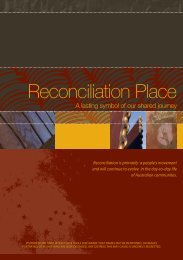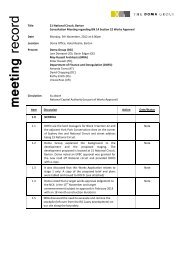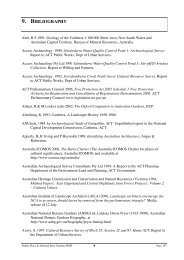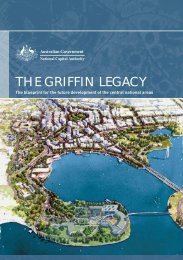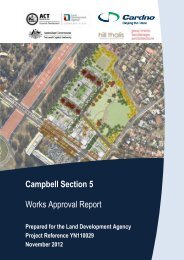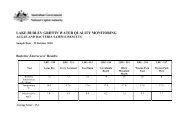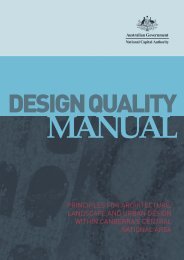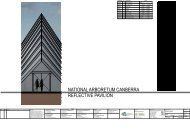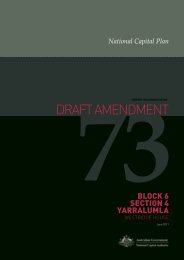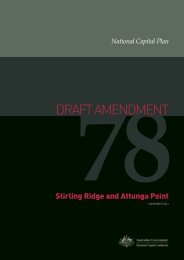A Self Guided Tour of Blundells Cottage - the National Capital ...
A Self Guided Tour of Blundells Cottage - the National Capital ...
A Self Guided Tour of Blundells Cottage - the National Capital ...
You also want an ePaper? Increase the reach of your titles
YUMPU automatically turns print PDFs into web optimized ePapers that Google loves.
<strong>Blundells</strong>’ <strong>Cottage</strong><br />
Step back in time at historic <strong>Blundells</strong>’ <strong>Cottage</strong>.<br />
Immerse yourself in <strong>the</strong> history <strong>of</strong> <strong>the</strong> cottage<br />
and use <strong>the</strong> hands-on displays to experience<br />
<strong>the</strong> stories <strong>of</strong> <strong>the</strong> people who lived <strong>the</strong>re.<br />
<strong>Blundells</strong> <strong>Cottage</strong> is open from 10am till 3pm<br />
Thursday, Friday and Saturday excluding public<br />
holidays. Admission fees are $7 adults, $5 concessions<br />
and $15 families.<br />
Special cottage tours are available for schools or o<strong>the</strong>r<br />
groups (bookings are essential).<br />
<strong>Blundells</strong>’ <strong>Cottage</strong><br />
Wendouree Drive, Parkes ACT<br />
GPO Box 373<br />
Canberra ACT 2601<br />
ph: (02) 6273 2667<br />
(<strong>Blundells</strong>’ <strong>Cottage</strong> 10am-3pm Thursday, Friday and<br />
Saturday)<br />
ph: (02) 6257 1068<br />
(<strong>National</strong> <strong>Capital</strong> Exhibition 9am-5pm)<br />
Fax: (02) 6273 8178<br />
Website: www.nationalcapital.gov.au<br />
Email: nce@natcap.gov.au<br />
Butter<br />
5. Kitchen & Office 6. Slab building 7. Garden<br />
Two additional rooms were added on to <strong>the</strong> cottage<br />
in 1888, <strong>the</strong> year that Joseph Lyle – <strong>the</strong> eighth child<br />
– was born to <strong>the</strong> <strong>Blundells</strong>. Initially, room five was<br />
used as a bedroom. It probably became a kitchen in<br />
<strong>the</strong> 1930s when <strong>the</strong> Oldfields moved into <strong>the</strong> cottage.<br />
“Moustache cup”<br />
After milking a cow, <strong>the</strong> milk is set aside<br />
and <strong>the</strong> cream rises to <strong>the</strong> top. The cream<br />
would keep longer if turned into butter.<br />
It was churned until it became hard and<br />
salt was added as a preservative.<br />
Many <strong>of</strong> <strong>the</strong> objects on display would<br />
have been in use until <strong>the</strong> 1940s and ’50s,<br />
although <strong>the</strong>y were invented much earlier.<br />
Also in this room is a Coolgardie Safe or<br />
Drip Safe. These were invented in Western<br />
Australia during <strong>the</strong> gold rush era.<br />
A predecessor to <strong>the</strong> refrigerator, it used<br />
only water and a slight breeze through<br />
<strong>the</strong> hessian to create a cooling effect.<br />
The safes have been known to achieve an<br />
eight degree drop in temperature. They<br />
were usually kept on <strong>the</strong> verandah.<br />
The room, which is now used as <strong>the</strong><br />
<strong>of</strong>fice, was probably a store room during<br />
<strong>the</strong> <strong>Blundells</strong>’ time.<br />
Most 19th century gentlemen had beards<br />
and moustaches. These special cups allowed<br />
gentlemen to sip <strong>the</strong>ir tea without getting<br />
<strong>the</strong>ir moustache wet. They feature a ledge<br />
<strong>of</strong> china on one edge <strong>of</strong> <strong>the</strong> cup rim, with a<br />
small opening to allow <strong>the</strong> tea to be sipped<br />
without wetting <strong>the</strong> whiskers.<br />
This building is believed to have been used as a kitchen<br />
until room five was converted into a kitchen in <strong>the</strong> 1930s.<br />
Separate kitchens were common at <strong>the</strong> time as a way <strong>of</strong><br />
managing <strong>the</strong> summer heat and <strong>the</strong> danger <strong>of</strong> fire.<br />
As <strong>the</strong> Blundell family grew, <strong>the</strong> older boys slept out<br />
here with <strong>the</strong>ir fa<strong>the</strong>r. They probably used camp beds<br />
and kept a wood stove alight.<br />
To <strong>the</strong> left <strong>of</strong> <strong>the</strong> door is a ‘corn crusher’ or mill. This was<br />
used to crush grain or corn kernels to be fed to animals.<br />
The slab building was built using a common preindustrial<br />
building method – which involved making<br />
thick timber planks by splitting tree trunks. This was<br />
done with hand tools, each ‘plank’ called a slab.<br />
Bellows and work tools<br />
Shoemaking equipment<br />
Shoemaking: lea<strong>the</strong>r was cut out using <strong>the</strong> curved<br />
blade. It was <strong>the</strong>n shaped and stitched around <strong>the</strong> shoe<br />
last or mould. Thick lea<strong>the</strong>r was nailed on for <strong>the</strong> sole<br />
and <strong>of</strong>ten metal caps were also nailed on. The metal<br />
caps helped <strong>the</strong> sole last longer on rough roads.<br />
Due to <strong>the</strong> isolation <strong>of</strong> <strong>the</strong> Canberra area, <strong>the</strong><br />
community relied greatly on <strong>the</strong> bullock teams to<br />
bring supplies from Sydney, particularly clothing and<br />
shoes. Therefore it was out <strong>of</strong> neccessity that shoes be<br />
repaired, allowing <strong>the</strong>m to be passed on to siblings.<br />
A bullock team could only travel about five to ten<br />
miles per day, compared with 12–18 miles a day with<br />
a horse and cart. The leading bullocks were <strong>the</strong> most<br />
experienced, while <strong>the</strong> polers (at <strong>the</strong> back) were <strong>the</strong><br />
strongest. George Blundell’s lead bullocks were called<br />
‘Smut’ and ‘Smiler’.<br />
Whaling pot<br />
Water tank<br />
The current garden was planted<br />
in 1964 when <strong>the</strong> cottage became<br />
a museum. The objects on<br />
display in <strong>the</strong> garden include a<br />
rabbit poison cart, a ship’s water<br />
tank and a whaling pot.<br />
In about 1888 <strong>the</strong> <strong>Blundells</strong> had<br />
a bread oven built on to <strong>the</strong><br />
east wall <strong>of</strong> <strong>the</strong> cottage. This<br />
is still present. The bread oven<br />
predates Murray’s Bakery,<br />
Canberra’s first commercial<br />
bakery, by twenty-one years.<br />
Murray’s Bakery was to <strong>the</strong> west<br />
<strong>of</strong> <strong>the</strong> cottage in (what is now)<br />
Commonwealth Park. It operated<br />
from 1909 to 1923.<br />
Even today, <strong>the</strong> cottage is not<br />
connected to town water.<br />
As <strong>the</strong> rabbit plague spread across Australia, various methods<br />
were employed to reduce <strong>the</strong>ir number. Poison such as phosphorous,<br />
strychnine or arsenic was mixed with bran and dropped around <strong>the</strong><br />
farms using poison carts like this one.<br />
At <strong>the</strong> back (east) <strong>of</strong> <strong>the</strong> slab building <strong>the</strong>re is a toilet.<br />
The ‘out house’ was originally much fur<strong>the</strong>r from <strong>the</strong><br />
cottage, near where <strong>the</strong> lake shore is now.<br />
To use a brick bread oven, a fire was<br />
made inside it first to heat it up. If a<br />
handful <strong>of</strong> flour thrown at <strong>the</strong> outside<br />
<strong>of</strong> <strong>the</strong> oven burned up with sparks,<br />
<strong>the</strong> oven was <strong>the</strong> right temperature.<br />
The embers were <strong>the</strong>n put out and <strong>the</strong><br />
risen dough put in and door closed.<br />
A <strong>Self</strong> <strong>Guided</strong> <strong>Tour</strong> <strong>of</strong><br />
<strong>Blundells</strong>’<br />
<strong>Cottage</strong><br />
A Look into <strong>the</strong> Past<br />
30 minute tour<br />
Wendouree Drive, on<br />
<strong>the</strong> nor<strong>the</strong>rn shore <strong>of</strong><br />
Lake Burley Griffin <strong>of</strong>f<br />
Constitution Avenue.<br />
11am–4pm daily<br />
A hands-on museum
Welcome to<br />
<strong>Blundells</strong>’ <strong>Cottage</strong><br />
This small stone cottage was built about 1860<br />
as a home for workers on <strong>the</strong> Duntroon Estate.<br />
A number <strong>of</strong> families lived in <strong>the</strong> cottage over <strong>the</strong><br />
hundred years it was occupied. The first two families,<br />
<strong>the</strong> Ginns and <strong>the</strong>n <strong>the</strong> <strong>Blundells</strong>, were employees <strong>of</strong><br />
Robert Campbell, who owned <strong>the</strong> Duntroon Estate.<br />
At its peak, <strong>the</strong><br />
The borders <strong>of</strong> Duntroon Estate<br />
stretched from <strong>the</strong> foot <strong>of</strong> Mt<br />
Ainslie to Wickserslack Lane, and<br />
from near Northbourne Avenue to<br />
well past Queanbeyan in <strong>the</strong> east.<br />
Duntroon sheep<br />
grazing estate<br />
encompassed 32 000<br />
acres (about 13 000<br />
hectares) and had about<br />
27 workers’ cottages.<br />
Robert Campbell founded <strong>the</strong> estate in 1825 when<br />
he was granted 4000 acres <strong>of</strong> land, 400 head <strong>of</strong><br />
sheep and £2000 as compensation for <strong>the</strong> loss <strong>of</strong> his<br />
ship, <strong>the</strong> ‘Sydney’. The ‘Sydney’ had sunk while on<br />
government business. Campbell was part <strong>of</strong> <strong>the</strong> East<br />
India trade. Today, <strong>the</strong> Campbell warehouses are still<br />
standing in The Rocks, at Circular Quay, Sydney.<br />
The landscape around <strong>the</strong> cottage was very<br />
different to what we see today. Paddocks and<br />
outbuildings surrounded <strong>the</strong> cottage. The nearest<br />
neighbour lived in a cottage located in what is now<br />
Commonwealth Park.<br />
O<strong>the</strong>r buildings that were<br />
part <strong>of</strong> <strong>the</strong> Duntroon<br />
Estate include Duntroon<br />
House, Mugga Mugga and<br />
Duntroon Dairy. These<br />
buildings are still standing<br />
today.<br />
Although most <strong>of</strong> <strong>the</strong><br />
objects and furnishings in<br />
<strong>the</strong> cottage did not belong<br />
to <strong>the</strong> <strong>Blundells</strong>, many<br />
were donated by o<strong>the</strong>r<br />
pioneer families and are<br />
typical <strong>of</strong> <strong>the</strong> period.<br />
Duntroon Estate, Limestone Plains 1910<br />
2<br />
4<br />
5<br />
‘Acton’ (formerly Canberry)<br />
1<br />
3<br />
7<br />
6<br />
<strong>Cottage</strong> floor plan.<br />
Numbers correspond<br />
to different rooms.<br />
1. Parlour<br />
Did you know: The photographs displayed in<br />
that seven <strong>of</strong> <strong>the</strong> eight <strong>the</strong> parlour are <strong>of</strong> <strong>the</strong> Blundell<br />
Blundell children were born family, who moved into <strong>the</strong><br />
in ei<strong>the</strong>r January or April. cottage in 1874. Flora became <strong>the</strong><br />
local midwife and delivered most<br />
<strong>of</strong> <strong>the</strong> babies born in <strong>the</strong> district. She was also a fine<br />
horsewoman.<br />
George was <strong>the</strong> bullock driver for <strong>the</strong> Campbells,<br />
taking wool to Sydney and returning with supplies<br />
such as flour, sugar, salt, clo<strong>the</strong>s, material and tools.<br />
The return trip lasted about 6 weeks. The bullock<br />
teams also went to Port Nelligen and Goulburn, and<br />
once <strong>the</strong> railway was established, <strong>the</strong>y started going<br />
to <strong>the</strong> closer location <strong>of</strong> Queanbeyan.<br />
The objects in this room are indicative <strong>of</strong> <strong>the</strong> types <strong>of</strong><br />
activities that were popular at <strong>the</strong> time. The <strong>Blundells</strong><br />
had a piano in <strong>the</strong> parlour and were known to have<br />
lively sing-alongs.<br />
Molonglo River<br />
St John’s church & schoolhouse<br />
Stereoscope<br />
Flora Blundell nee McLennan<br />
Flora was born on <strong>the</strong> Isle <strong>of</strong> Skye, Scotland,<br />
in 1845, and emigrated to Australia with her<br />
family when she was aged nine. Flora was a<br />
traditional name in her family – both her mo<strong>the</strong>r<br />
and grandmo<strong>the</strong>r were named Flora – and in<br />
turn she used <strong>the</strong> name for one <strong>of</strong> her children.<br />
Zi<strong>the</strong>r<br />
Harmonium<br />
<strong>Blundells</strong>’ <strong>Cottage</strong><br />
O<strong>the</strong>r evening activities, such<br />
as sewing, reading and writing,<br />
were all done by <strong>the</strong> light <strong>of</strong><br />
kerosene lamps and candles.<br />
Stereoscopes, with a set <strong>of</strong><br />
photos, were ano<strong>the</strong>r form<br />
<strong>of</strong> entertainment. Stereo<br />
photographs are photos taken<br />
at <strong>the</strong> same time from two<br />
different angles. When seen<br />
through <strong>the</strong> viewer, our eyes<br />
compensate and <strong>the</strong> photo<br />
appears three-dimensional.<br />
The instrument on <strong>the</strong> table is<br />
a zi<strong>the</strong>r, which was played with<br />
a pick or by fingers.<br />
At about <strong>the</strong> same time as<br />
<strong>Blundells</strong>’ <strong>Cottage</strong> was built,<br />
this harmonium was made in<br />
France. Air is pumped into<br />
<strong>the</strong> small reed organ by <strong>the</strong><br />
bellows, which is operated by<br />
pushing <strong>the</strong> pedal with your<br />
feet. Music is created when<br />
keys on <strong>the</strong> keyboard are<br />
pressed and <strong>the</strong> air is released.<br />
In <strong>the</strong> ninteenth century childbirth was risky and an experienced midwife<br />
was invaluable. At this time mo<strong>the</strong>rs stayed in bed for at least 10 days<br />
after giving birth.<br />
Nineteenth Century midwife’s equipment list:<br />
basins <strong>of</strong> hot and cold water, warm blankets & towels, needle & thread,<br />
safety pins, olive oil, scissors, petroleum jelly or lard, brandy, footbath,<br />
fan, Condy’s fluid, a syringe, napkins, waterpro<strong>of</strong> sheeting, binder<br />
(around abdomen).In some rural areas <strong>the</strong> birth <strong>of</strong> a child was announced<br />
by putting a cushion on <strong>the</strong> doorstep: blue for a boy, pink for a girl, and<br />
black for a child that was stillborn.<br />
Rottenbury’s house<br />
2. Front bedroom<br />
Agnes (sitting) and Gertrude Ginn,<br />
<strong>the</strong> daughters <strong>of</strong> <strong>the</strong> family for whom<br />
<strong>the</strong> cottage was built. Gertrude, born<br />
21 September 1865, was <strong>the</strong> first <strong>of</strong><br />
many babies born in <strong>the</strong> cottage.<br />
William and Mary Ginn and <strong>the</strong>ir<br />
children were <strong>the</strong> first family to<br />
live in <strong>the</strong> cottage. William Ginn<br />
was <strong>the</strong> head ploughman for <strong>the</strong><br />
estate. His employment by Robert<br />
Campbell had been arranged in<br />
England before <strong>the</strong>y emigrated.<br />
The Ginns brought with <strong>the</strong>m<br />
a muzzle-loading gun and a four-poster bed. The<br />
family stayed in <strong>the</strong> cottage for 14 years before buying<br />
a property at ‘Canberry Park’.<br />
The hot water bottle, or ‘bed pig’,<br />
on <strong>the</strong> bed would have been much<br />
appreciated during Canberra winters.<br />
Before houses had indoor toilets<br />
and bathrooms, a wash stand was<br />
common bedroom furniture. It<br />
holds a jug and basin for a morning<br />
wash, and a chamber pot that meant<br />
you did not have to make a trip to<br />
<strong>the</strong> outside toilet in <strong>the</strong><br />
middle <strong>of</strong> <strong>the</strong> night.<br />
On <strong>the</strong> dresser are<br />
curling irons and glove<br />
stretchers. The curling<br />
irons had to be heated<br />
carefully because, if <strong>the</strong>y<br />
were too hot, <strong>the</strong> smell <strong>of</strong><br />
burning hair would soon<br />
alert <strong>the</strong> user. Glove<br />
stretchers were used to<br />
stretch gloves back to<br />
<strong>the</strong>ir original shape after<br />
<strong>the</strong>y had been washed.<br />
Wash stand<br />
Hot water bottle<br />
Curling iron & glove stretcher<br />
3. Work room<br />
This room had various uses over <strong>the</strong> one hundred<br />
years that <strong>the</strong> cottage was occupied. It is probable<br />
that it was a winter bath area during <strong>the</strong> Blundell<br />
era, with bath water being carried up from <strong>the</strong> river<br />
and heated over <strong>the</strong> fire. Each family member ba<strong>the</strong>d<br />
in turn, generally on Saturday nights. The soap was<br />
made from animal fat and borax or lye.<br />
It may have also functioned as a work room for<br />
lea<strong>the</strong>rworking, ironing, and extracting honey from<br />
<strong>the</strong> Blundell family’s beehives.<br />
The original shingle<br />
ro<strong>of</strong> can be seen<br />
through a space in <strong>the</strong><br />
hessian ceiling. Each<br />
shingle was held by<br />
only one nail to avoid<br />
splitting.<br />
These irons were ei<strong>the</strong>r filled<br />
with hot coals, or heated on<br />
stoves or in fires. A major<br />
advance was made in 1870,<br />
when American housewife<br />
Mary Potts patented an iron<br />
designed to stay hot for longer,<br />
and with a wooden handle to<br />
prevent <strong>the</strong> user from getting<br />
burned. Her invention became<br />
famously known as <strong>the</strong> ‘Mrs<br />
Potts iron’<br />
Parbuckling<br />
The Blundell boys had to pull barrels <strong>of</strong> water up<br />
from <strong>the</strong> river on homemade tracks. This was called<br />
‘parbuckling’.<br />
Beekeeping<br />
The frames from <strong>the</strong> hives were put into mosquito<br />
netting bags and were taken to an enclosed space,<br />
usually a room in <strong>the</strong> house. The wax covering <strong>the</strong><br />
full cells was scraped <strong>of</strong>f with a special knife and <strong>the</strong>n<br />
<strong>the</strong> honeycombs were crushed between <strong>the</strong> hands so<br />
that <strong>the</strong> honey would flow out. The bags were hung<br />
up over containers until <strong>the</strong> honey drained. The bits<br />
<strong>of</strong> comb (wax) remained in <strong>the</strong> bags.<br />
4. Girls’ room<br />
Children generally shared beds when space<br />
and money were limited. Bedrooms were<br />
gender segregated in <strong>the</strong> <strong>Blundells</strong>’ time.<br />
‘Knuckles’ or ‘Jacks’ was a game played with<br />
sheep’s knucklebones. Players would try<br />
to pick up knuckles before <strong>the</strong> one <strong>the</strong>y had<br />
thrown in <strong>the</strong> air landed.<br />
O<strong>the</strong>r popular toys <strong>of</strong> <strong>the</strong> time were skipping<br />
ropes, hoops, hobby horses and soldiers.



